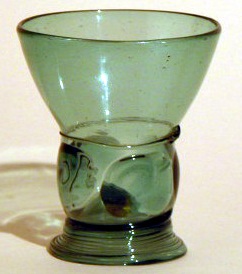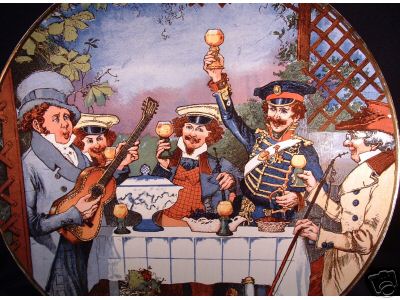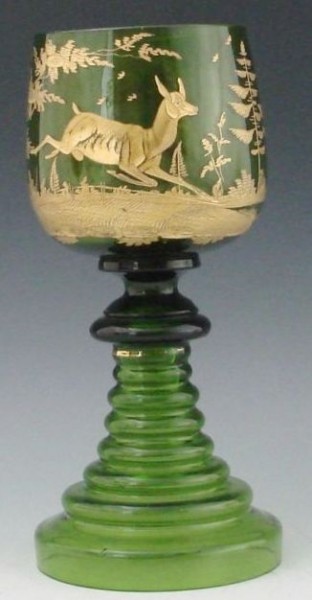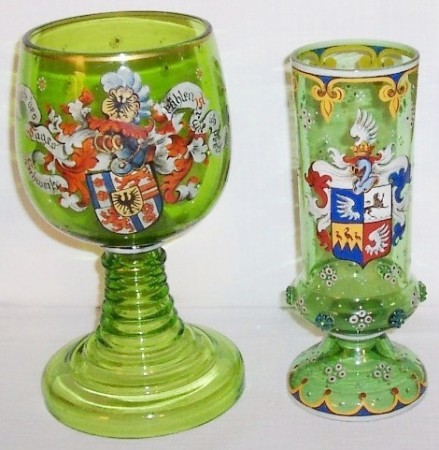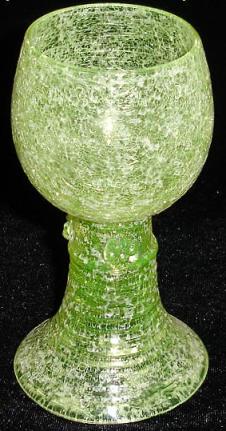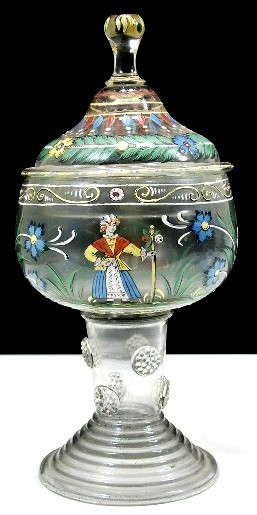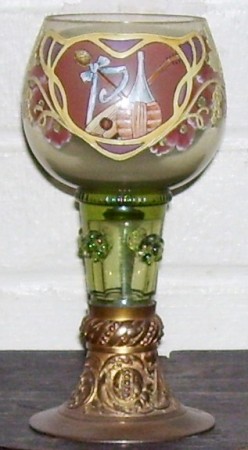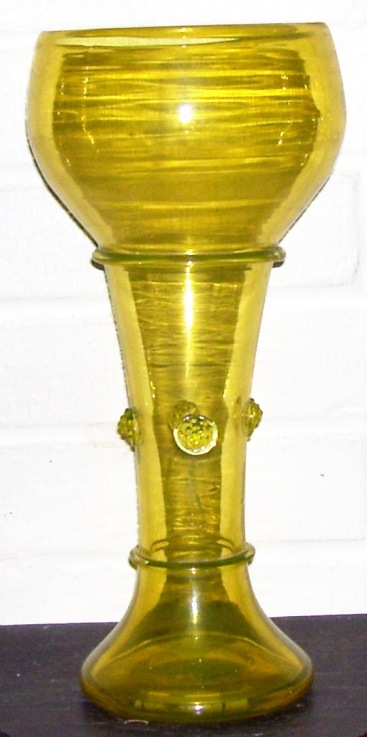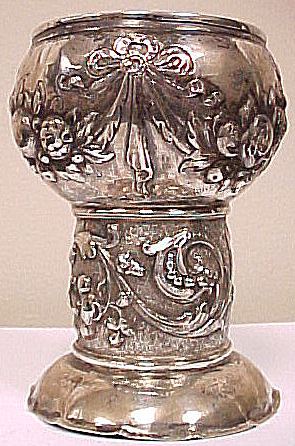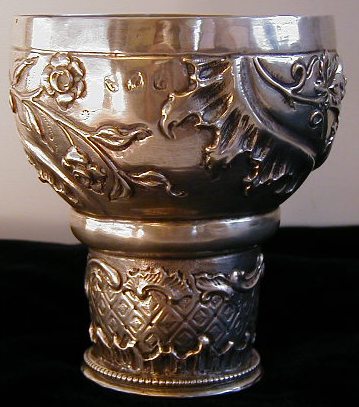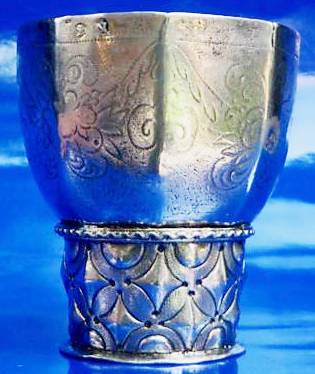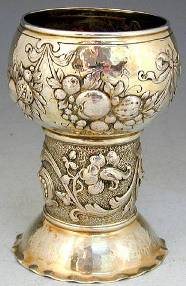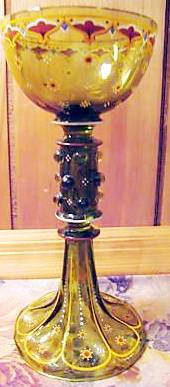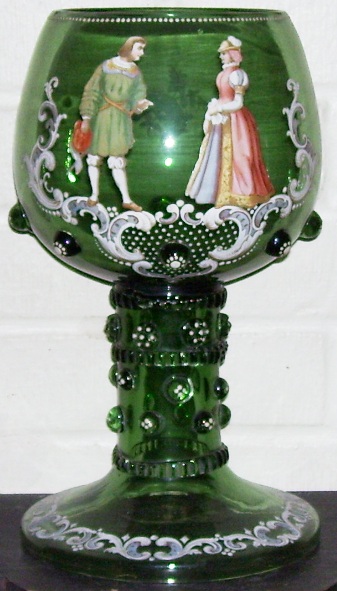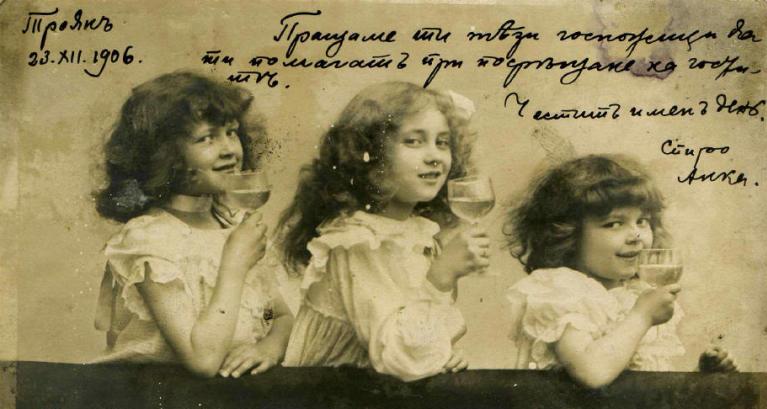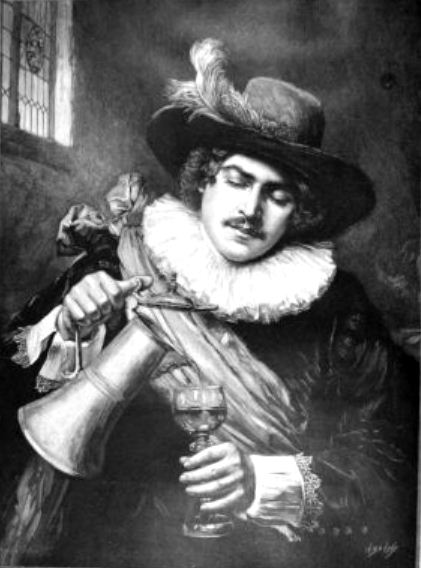
Pewter flagon and a blown glass roemer. Print dated 1903.
An (only) 3.6 inch tall Roemer, from the Netherlands. Circa 1600. The asking price was 11,000.00 Euro in 2009!
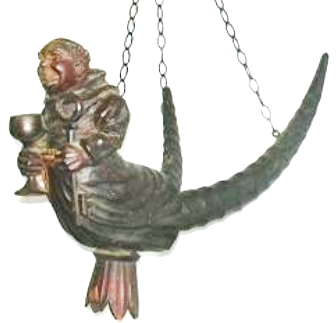
Holding a roemer, a German tavern’s “Lusterman” (made of molded gesso over thin wood, and real horns) which were hung above some of the favorite tables in the German pubs. These usually had candles holders attached; later electric light. (This was in the S M & T, but I really had no place to hang it.) Originals are very, very hard to find nowadays.
____________________________________________________
A very brief history behind the wine drinking vessel called “Roemer” = Roman, for which it was named.
But first please read all of “Herman’s Story” on this web site first = http://www.steveonsteins.com/hermanns-story
Steve’s note: Basically all the history written below in blue on this page, but condensed:
After Hermann beat the Romans so badly, and subsequent battles failed to conquer the tribes of “barbarians,” the Roman settled on the Western banks of the Rhine river, mostly for defensive purposes. The Roman soldiers of course liked to drink wine having grown up with it in their home country, and the hills around the Rhine were conducive to growing grapes, even if in a shorter season.
Some of the real history is copied below in blue should you wish to learn more:
“A few years earlier : Caesar’s Gallic War”
Caesar set out to conquer the wealthy country of Gaul, largely today’s France and Belgium. In seven years of campaigning, he fought the Celtic tribes there, but also Germanic tribes who crossed the Rhine: the Sugambri, the Usipetes and the Tencteri. Two times Caesar had bridges built and crossed the Rhine. In 52, (BCE) Caesar controlled Gaul. One last time, the Gauls led by the famous Arveni Vercingetorix rebelled and even defeated Caesar, but then they were trapped in the fortress of Alesia, besieged, and eventually forced to surrender. It was Caesar’s Gallic campaign that brought the Roman legions to the Rhine river.
Caesar himself wrote about his campaigns in his book “De bello gallico”, and he describes the various “barbarian” tribes that he defeated. And it is Caesar who brought up the term “Germanics” for the “barbarians” living on the right bank of the Rhine. He described them as even more “barbaric” than the Celts, as dangerous, belligerent people who were an ongoing threat to the new Roman territories.
Yet, Caesar was wrong. Although mainly Celtic tribes like the Treveri and the Eburoni lived on the left bank and others, according to Caesar Germanic tribes like the Sugambri, the Tencteri, the Usipetes and the Ubii lived on the right bank, the Rhine was neither a political nor a cultural border yet
There were Germanics who crossed the Rhine to settle on the left bank, and Celts who lived on the right bank.
Now comes Hermann’s story in this time frame:
By this defeat the Romans lost all their conquests beyond that river; and although Germanicus some years after again carried their arms to the Weser, they never established anything like a solid dominion over those regions.
The defeat of Varus occurred, according to various chronologists, in the year 763 of Rome (A.D. 9). The scene of the defeat is conjectured to have been in the country of the Bructeri, near the sources of the Ems and the Lippe.
The legions were entirely destroyed, and the cavalry alone cut their way through the enemy and regained the banks of the Rhine.
The news of this calamity, the greatest that had befallen the Roman arms since the defeat of Crassus, was received with universal amazement and terror. The despairing cry of Augustus, “Varus, Varus, give me back my legions!” testified to the consternation even at Rome, where it was expected that the barbarians would take a terrible revenge for the wrongs they had suffered.
The fears of invasion, however, were not realized. L. Asprena guarded the banks of the Rhine, and the Germans were too little united among themselves to attack the Empire.
Augustus in the following year sent Tiberius to the Rhine with a fresh army; but he does not seem to have effected anything of importance. Hermann meantime quarrelled with Segestes, chief of the Catti, whose daughter Tusnelda, he had carried off and married against her father’s consent.
When Germanicus, after the death of Augustus, marched into the interior of Germany to avenge the defeat of Varus, he was assisted by Segestes, and also by the Chauci and other tribes.
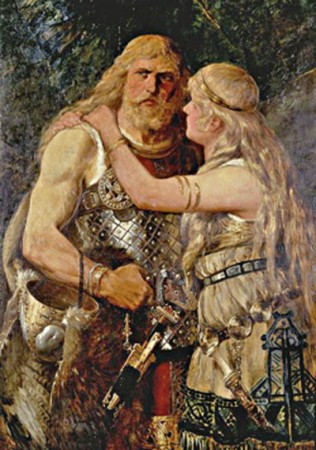
In the first retaliatory battle against Hermann, his wife Tusnelda, was taken prisoner by the Romans, and she afterward figured in the triumph of Germanicus. Germanicus, having reached the scene of Varus’s defeat, paid funeral honors to the remains of the legions; but Hermann, who was hovering about his line of march, without coming to a pitched battle, harassed him in his retreat, and occasioned a great loss to Cæcina, the lieutenant of Germanicus.
In the following year, Germanicus advanced again as far as the Visurgis, or Weser, where he found Hermann encamped ready for battle. A desperate fight took place, in which Hermann, after performing prodigies of valor, was defeated, and escaped with difficulty. But the victory was gained at such cost that Germanicus and his army had to take refuge in their ships, nor did the Romans ever again attempt the conquest of the fiercer German tribes.
When Tiberius recalled Germanicus, he observed that the Cherusci, Bructeri, and other unsubdued tribes, might be left to their own internal dissensions. He seems to have guessed right.”
Well, Germanicus never catured or killed Hermann, but he did capture his wife Tusnilda, and their boy child, and took them back to Rome, where they were paraded as slaves. After that last minor skimish, The Roman soldiers then returned back across the Rhine, strengthened their fortifications and never ventured too far into the badlands occupied by the Germanic tribes.
Germanicus was recalled to Rome and the advantages gained were lost. After this time, no Roman army ventured to penetrate the interior of Germany. After the expulsion of the Romans, internal feuds broke out among the Teutonic tribes, and Hermann (Arminius) was slain by some of his relatives. (You may be saying: Didn’t we see this same story line in the movie “Zulu?”)
As the Romans, now fortified along the east side of Rhine, had mostly come from Italy, it was only natural for them to drink wine as their drink of choice. The local German’s (some whose tribes had fought the Romans before) were only too glad to accommodate them, as money was money even way back then. Thus began the now internationally known area of wine growing around the Rhine, Moselle, and Neckar rivers. The grapes that produced white wine were the best for growing along the river sloops.
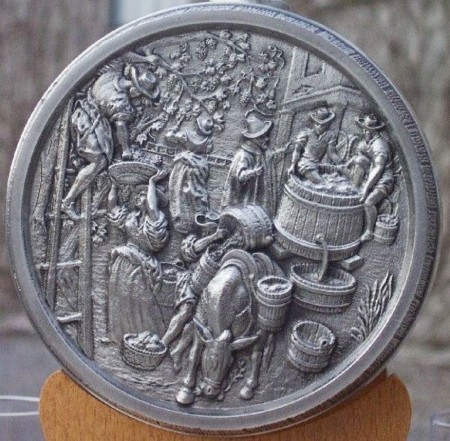
Slightly after the Roman time period, but the process of making the wine was the same. Picking the grapes, hauling them, and then stomping out the juices , then to the wooden kegs. Shown: The end of a pewter wine barrel, the design circa 1970.
Detail from THE V & B Mettlach PUG plaque No. 1044-1144.
Below ▼: The great wine production centers of Germany, home of The Roemer! A newer pottery relief stein. .5 liter [?] PUG.
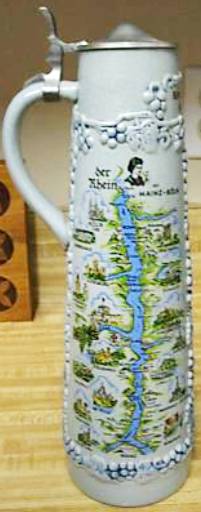
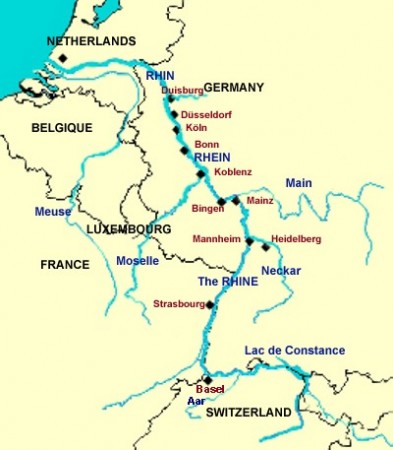
from http://www.rhinedragon.de/romans-germanics-01.htm
BELOW: A FEW “THERESIENTHAL” GLASHÜTTE ENAMELED “ROEMERS” ▼
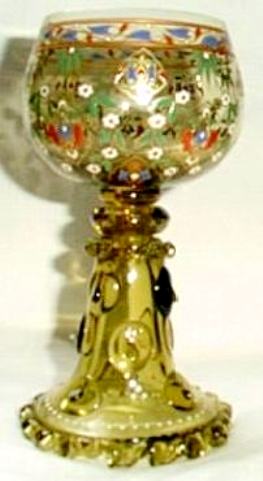
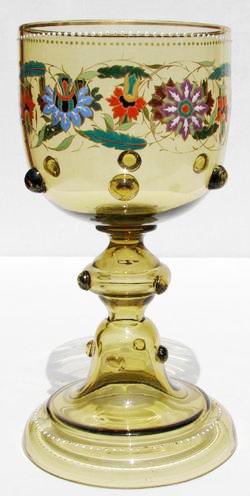
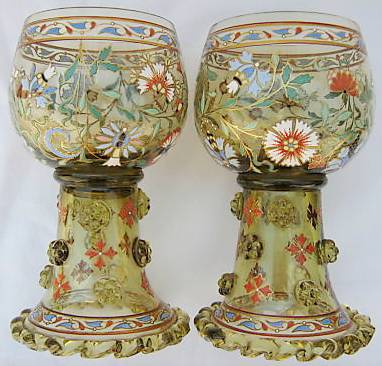
One of the most sought after design by Theresienthal, above ▲.[FWTD] For more Theresienthal roemers, please go to this tab, this page: Theresienthal [6] glass wine roemers @: http://www.steveonsteins.com/in-the-near-future-2-1-1
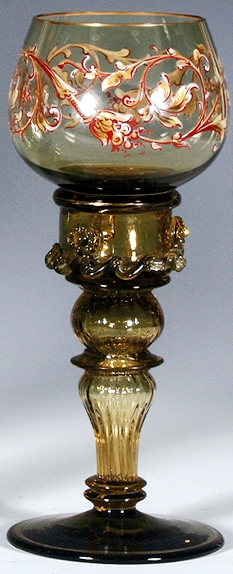
I am not certain at all who made this “low cup” / “fluted stem” roemer. Possibly Theriesenthal.
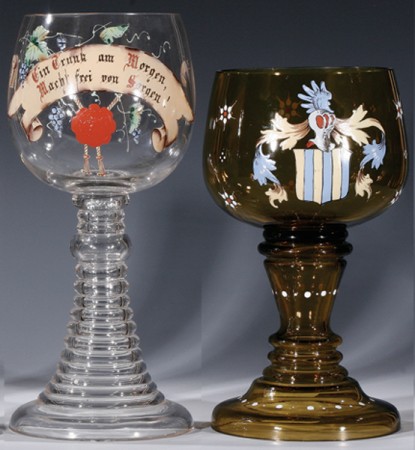
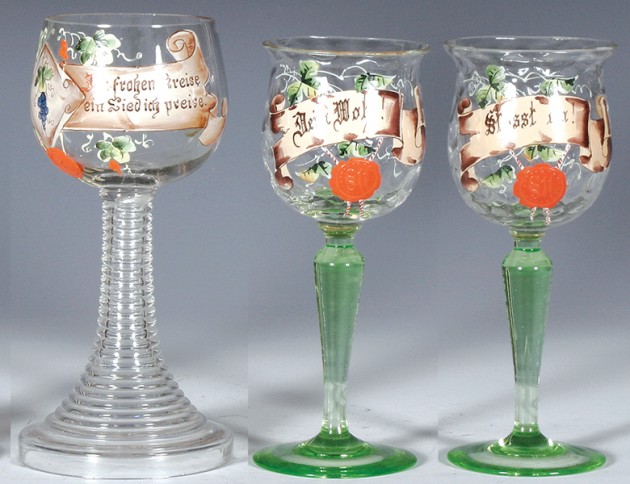
See: ” Red Seal “in this site’s Compendium. “R”
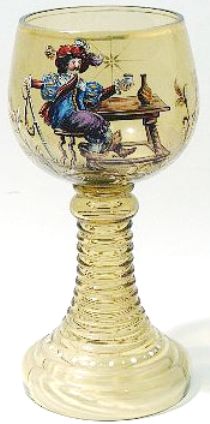
Enameled “Lansquenet” on a 10 inch tall roemer. [FWTD]
![ROEMER TH [?] 7 INCH](http://www.steveonsteins.com/wp-content/uploads/2010/08/ROEMER-TH-7-INCH-WITH-CHIP-ON-LIP--348x600.jpg)
Roemer by Lobemyer or Josephinenhütte? Theresienthal is not noted for enameling their prunts.
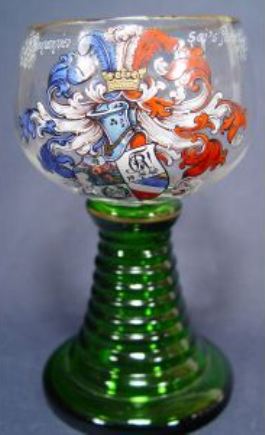
A dueling society Coat of Arms roemer. Probably enameled at a private decorator’s shop.
A very well done roemer with enameled prunts . I believe it to be Josephinenhütte. [FWTD]
Below ▼ : A few more of the modest ones ($$$ wise.)
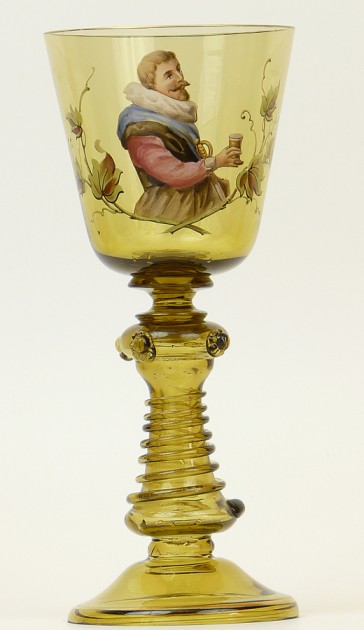
By Josephinenhütte? For more on this maker please see: http://www.steveonsteins.com/josephinenhutte-glass-drinking-vessels-at-the-s-m-t-draft-3-30
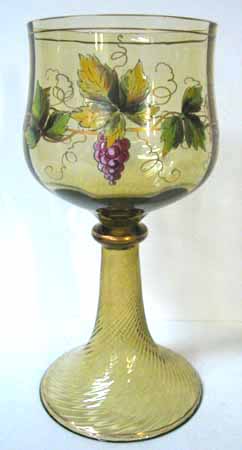
A very nice simple grape / vine design, most likely by Josephinenhütte.
A very much modern day roemer both is style and the lack of detail in the cutting. 8 inches tall. Circa 1950-90.
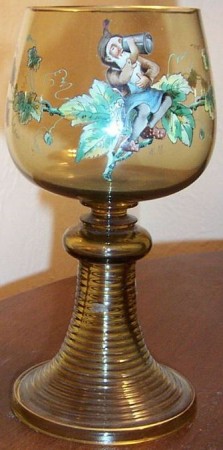
Another smaller one, 5 inches tall, signed “Heckert.” [FWTD]
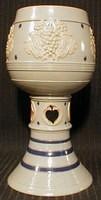
V & B Mettlach. # 2952 . With card suits as decor. (S C)
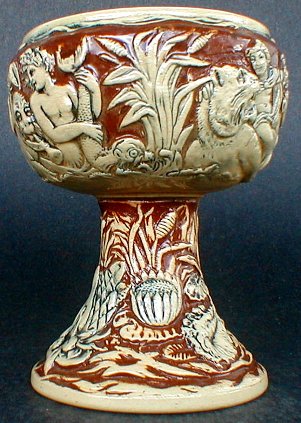
.
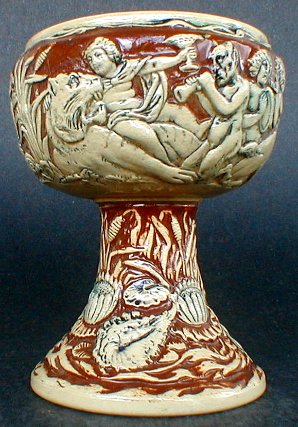
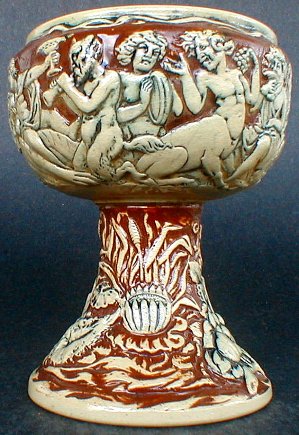
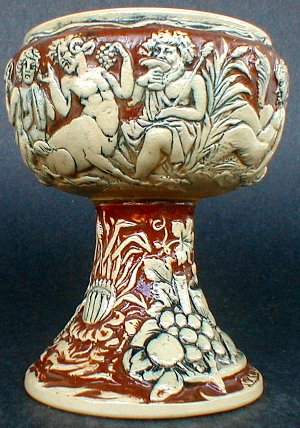
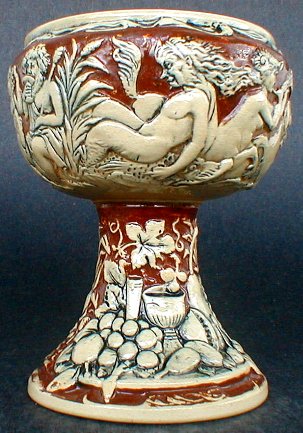
.
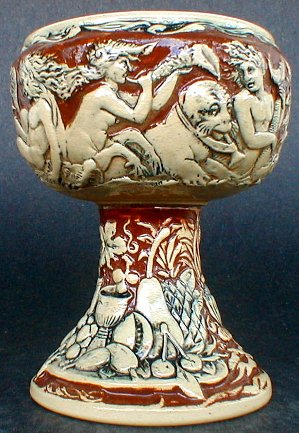
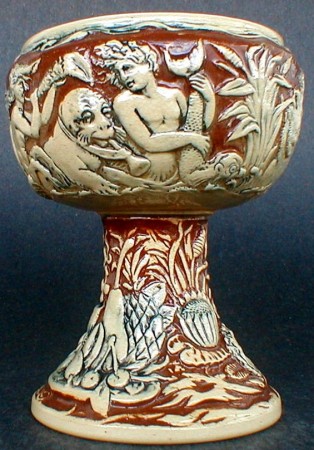
Pottery roemers -5 inches tall, made by ? in the Westerwald, Circa 1890. Greek Gods: Poseidon, Neptune, Bacchus, Saturnalia, etc, etc . Circa 1900. This is an unusual pottery roemer that depicts both land and sea mythological creatures having a party. One half is devoted to those on the land; the opposite side to those living under the sea. (Comp. W. B.)
Two Eggerman pieces. The dark green color is the determinator, along with the yellow-orange egg and dart design on the lip of the beaker. [Both Ex-FWTD]
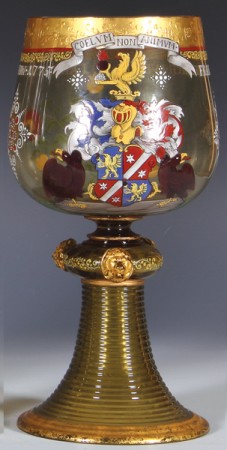
An even nicer family;s armorial roemer, probably by Eggerman’s workshop.
3.5 inch. Vaseline glass, unknown maker.
Enameled folk style roemer. 11.5 inches tall. I am pretty certain this one is a newer made piece and design.
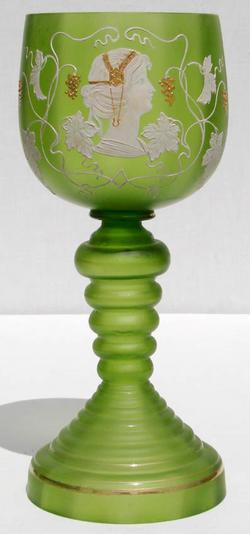
Hand enameled, Art Nouveau, French?
Below: Two modern day roemers, designed and made by a retired silver-smith for Stieff Silver Co. Baltimore. I bought these from an antiques shop in downtown Baltimore @ Fell’s Point a few years back. Both are about 6 inches tall and heavy.[ FWTD]
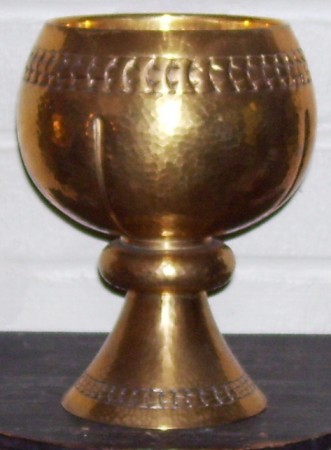
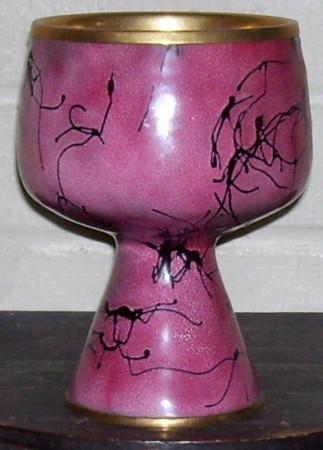
A smaller “van Hauten” enameled roemer; the glass was probably made by Theresienthal.[FWTD]
Now a couple of slightly classier pieces,. I mean if you were to have only one roemer, it may as well look like one of these, hey ?
My original attribution: A massive 12,5 inch “Dutch/ Brabant” roemer made out of Uranium glass. Circa 1830 – 40. [FWTD].
[Uranium glass is now called Vasoline glass here in the USA. See below.]
Now one of the thing I like about doing this web site is that I learn about as much as I teach. This photo and description ▲ prompted an exchange with a eBay glass dealer who had picked up the same piece.
I based my age estimate on the fact that the base was very worn with years of accumulated scratches, like other comparable pieces I have looked at and owned over these many years.
However It was later determined I MIGHT be wrong, and on two accounts. (If so ~ it would be the first time this year! The other time I thought I had made a mistake!!)
This piece might be American, not Bohemian, and may be a lot newer than it appears. It could have been made by “Pairpont” glass. The lady glass dealer was kind enough to allow me to display her research into exactly who she thought made it. ▼ Two photos below one will see the catalog page where is is labeled a “Vase” and painted as such; and then the photo of her piece identical to mine but noted as being one inch smaller.
There is slight difference in listed size and then there is the body decoration, I’ll be willing to bet you money Pairpoint didn’t come up with the design, but copied an earlier Bohemian piece, and my roemer and her’s may have been it. And mine really is really from Bohemia or Germany and not American. Until I see a catalog page without the enameling and stated that it is Uranium or Pink glass (as I have also seen one all in Pink in New Hampshire Mall about 8 years ago – (I now wish I had measured it, but it had a crack so I didn’t buy it!)
I will not be convinced (as my family came from St. Thomas stock!!) So in my mind, the jury is still far out on this piece!!
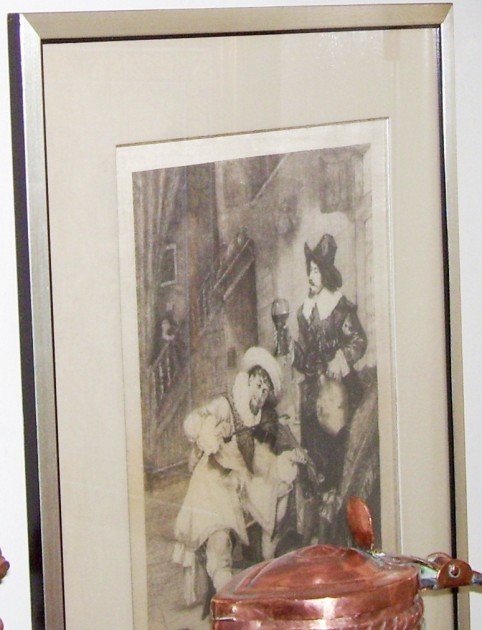
Original attribution: Art work showing two Dutch men imbibing some wine. The roemer the man on the right is holding is about the same size as the shown just above. ▲ [FWTD]
.
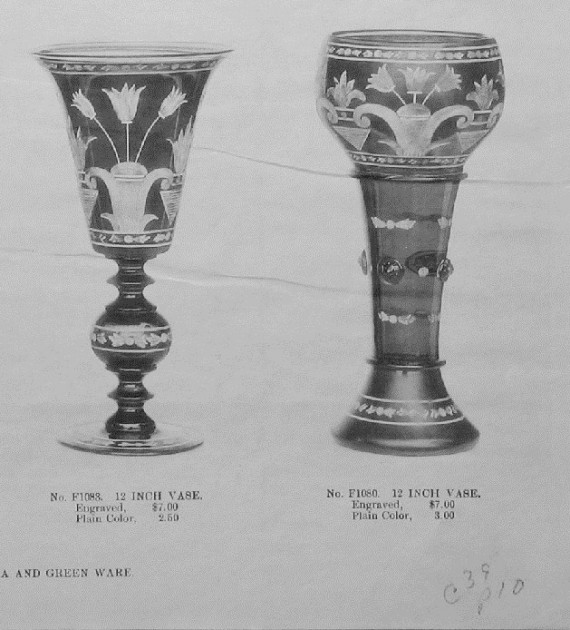
And Pairpoint labeled it as “green ware” and a “vase.”
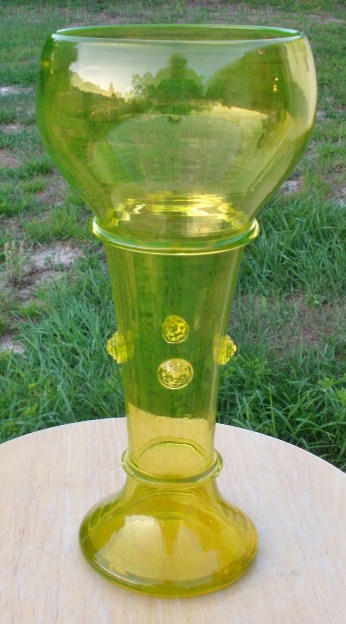
The eBay dealer described her’s (shown above ▲as being 13 inches tall, whereas the Pairpoint catalog says 12. But I can also assume being hand done that they could vary as much as a inch easily.
A related note from: http://www.go-star.com/antiquing/vaseline_glass.htm
The Vaseline Glass Collectors, Inc., uses the following definition: “Vaseline glass is a transparent, yellow-green glass that will fluoresce a bright green color when exposed to any ultraviolet light source, due to the addition of a 1%-2% amount of uranium dioxide in the original glass formula. The transparent quality may be obscured by treatments such as opalescent, carnival, iridizing, stretch, satinizing, sand or acid etching, casing, inclusion and cutting treatments. Hand painted and applied decorations are also acceptable. These treatments do not change the original transparent quality of the glass. The name vaseline glass is due to the similarity of the color to that of petroleum jelly as it appeared in 1901.”
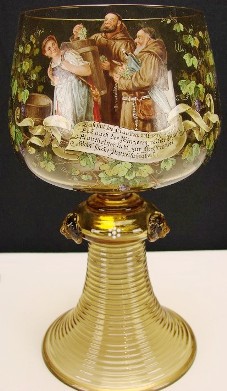
A copy of a famous antique German oil painting. This roemer is signed by “Heckert” also. [FWTD]
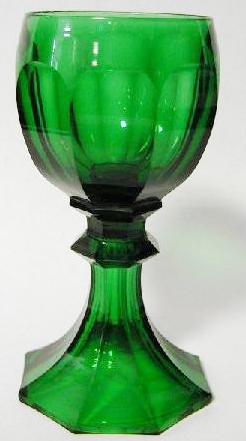
Brilliant leaded green glass. Not stained! This is called “Russian green”by some collectors. Beautifully cut. Unknown maker. (Possibly by Josef Hoffmann, Wiener Werkstätten.) Circa 1840 – 50.
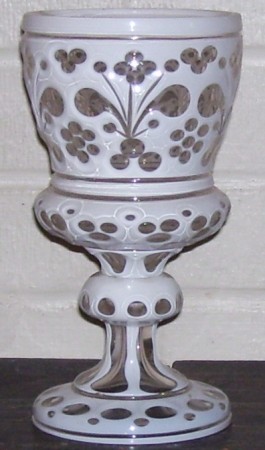
Cased glass. Josephinenhütte, Circa 1850.[FWTD]
For more on this maker please see: http://www.steveonsteins.com/josephinenhutte-glass-drinking-vessels-at-the-s-m-t-draft-3-30
[ L].8oo Silver German roemer, 4.5 inches tall. [R] .8oo Silver German roemer, only 3 inches tall. [FWTD] These small “antique “silver ones are usually expensive when found.
[L] Silver, 17th Century and only 2.75 inches. Quite expensive. [R] Silver, 4.7 inches tall. [FWTD]
Tall and thin, very elaborate. Probably by Eggerman. [FWTD]
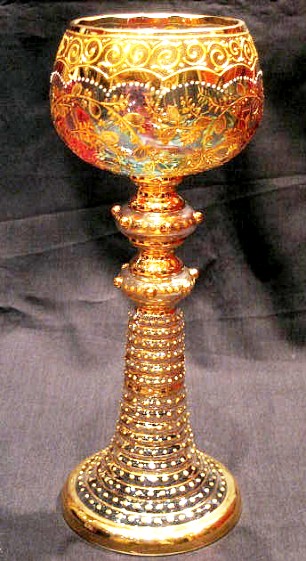
8.25 Inches tall, called Moser. More than likely it is by “Meyr’s Neffe.”
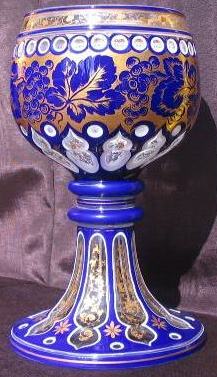
Made by the ‘Josephinenhütte’ firm in Bavaria. Circa 1860. [FWTD]
For more see the page on Josephinenhütte glass vessels, this web site: http://www.steveonsteins.com/josephinenhutte-glass-drinking-vessels-at-the-s-m-t-draft-3-30
One of a pair, made as wedding gifts. 12 inches tall. Gorgeous hand done enameling; “probably” by Josephinenhütte. Circa 1860 -80. [FWTD]
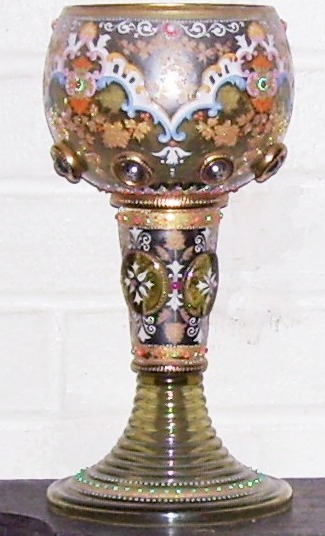
Another one of a pair, made as wedding gifts.“Meyr’s Neffe ?”
Above ▲, the “Mother of all Roemers.” What this piece (really a pair here at the S M & T) doesn’t have I do not know! It has a ribbed stem, about four major enameled colors designs, the white enameled dot pattern, applied green glass dots at the bottom, large enameled prunts with smaller round in round prunts, a serrated enameled glass ring above the gilded enameled ring with applied green and red glass dots, crushed gold leaves and a gold ringed lip! Plus a small amount of silvering to form a reflective surface. I am now (end of 2012) not at all certain these were custom made for a marriage by Theresienthal glashütte in Bavaria.
All the colors look more TH than Josephinenhütte or Myers Nef, but I can find no other examples of the round-in-round gilded nipple prunts on other TH work. But who but the glass specialist really cares? I do not. They are just damn attractive! Circa 1875-85. [FWTD]
Krys, Beth and Lena, three young women, all wine drinkers, in our family, shown on a dated 1906 postcard.
[END – SP104 — 60 – R5 ]
 “It’s O.K. to laugh during sex . just don’t point!”
“It’s O.K. to laugh during sex . just don’t point!”

